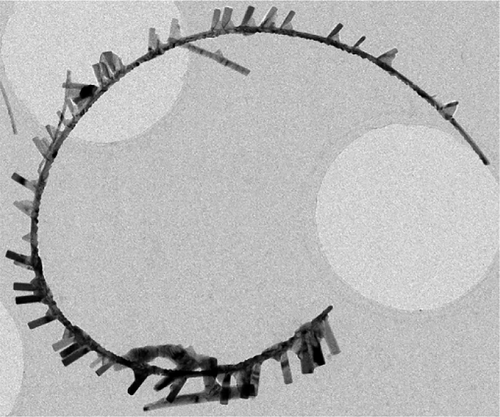当前位置:
X-MOL 学术
›
Cryst. Growth Des.
›
论文详情
Our official English website, www.x-mol.net, welcomes your feedback! (Note: you will need to create a separate account there.)
ZnS–ZnO Heterostructure Nanorings Grown under a Possible Early Earth Atmosphere
Crystal Growth & Design ( IF 3.8 ) Pub Date : 2020-01-21 , DOI: 10.1021/acs.cgd.9b01476 Jae Min Park 1 , Seung Hwan Oh 1 , Yong Kim 1
Crystal Growth & Design ( IF 3.8 ) Pub Date : 2020-01-21 , DOI: 10.1021/acs.cgd.9b01476 Jae Min Park 1 , Seung Hwan Oh 1 , Yong Kim 1
Affiliation

|
We synthesize ZnS–ZnO heterostructure nanorings at ∼680 °C under carrier gases with various [CO2]/[N2] ratios simulating an anoxic and weakly reduced atmosphere on early Earth. The synthesized nanorings consist of a ZnS–ZnO bilayered stem, ZnO teeth, and ZnS wing-like structures between the teeth and the ZnS layer. O atoms are supplied through the decomposition of CO2 presumably catalyzed by the ZnS surface. The respective growth directions of ZnS and ZnO layers in the stem are [0001] and [011̅1], and ZnO teeth are directed outward from the ring. The nanorings are structurally different from ZnS–ZnO nanorings having inward-directed teeth, which were grown under an oxygen-containing ambient environment. Contrary to the assumption of sulfide dominance including ZnS and MnS while disregarding oxygen-containing minerals such as ZnO on early Earth, we show that ZnS–ZnO nanorings, which are more advantageous in CO2 reduction efficiency, could be formed.
中文翻译:

在可能的早期地球大气下生长的ZnS–ZnO异质结构纳米环
我们在〜680°C的载气下以各种[CO 2 ] / [N 2 ]比率合成了ZnS–ZnO异质结构纳米环,以模拟地球早期的缺氧和弱还原性大气。合成的纳米环由ZnS-ZnO双层茎,ZnO齿以及在齿和ZnS层之间的ZnS翼状结构组成。通过分解CO 2来提供O原子大概是由ZnS表面催化的。茎中ZnS和ZnO层的生长方向分别为[0001]和[011̅1],并且ZnO齿从环中向外指向。纳米环在结构上与具有向内齿的ZnS–ZnO纳米环不同,后者在含氧的环境下生长。与不考虑地球早期的含氧矿物(如ZnO)而假设的硫化物占主导地位的ZnS和MnS相反,我们证明可以形成ZnS-ZnO纳米环,该环在降低CO 2效率方面更具优势。
更新日期:2020-01-22
中文翻译:

在可能的早期地球大气下生长的ZnS–ZnO异质结构纳米环
我们在〜680°C的载气下以各种[CO 2 ] / [N 2 ]比率合成了ZnS–ZnO异质结构纳米环,以模拟地球早期的缺氧和弱还原性大气。合成的纳米环由ZnS-ZnO双层茎,ZnO齿以及在齿和ZnS层之间的ZnS翼状结构组成。通过分解CO 2来提供O原子大概是由ZnS表面催化的。茎中ZnS和ZnO层的生长方向分别为[0001]和[011̅1],并且ZnO齿从环中向外指向。纳米环在结构上与具有向内齿的ZnS–ZnO纳米环不同,后者在含氧的环境下生长。与不考虑地球早期的含氧矿物(如ZnO)而假设的硫化物占主导地位的ZnS和MnS相反,我们证明可以形成ZnS-ZnO纳米环,该环在降低CO 2效率方面更具优势。



























 京公网安备 11010802027423号
京公网安备 11010802027423号